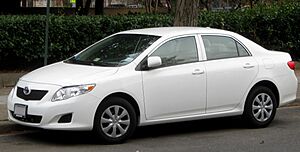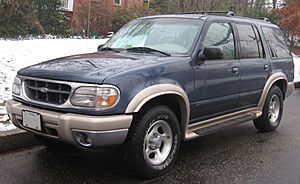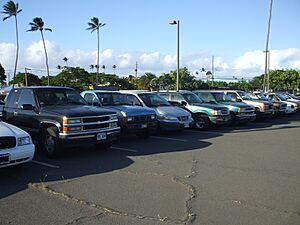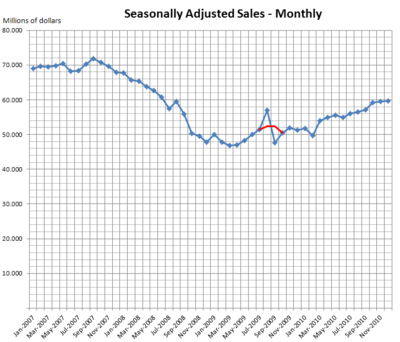Car Allowance Rebate System facts for kids
The Car Allowance Rebate System (CARS), often called "cash for clunkers", was a special program in the U.S.. It offered $3 billion to help people buy new, more fuel-efficient cars. To get the money, you had to trade in an older, less fuel-efficient vehicle.
This program was created after a big economic slowdown (the Great Recession). Its main goals were to help car sales, which had dropped a lot, and to get more fuel-efficient cars on the roads. This would help the environment and save gas.
The program officially started on July 1, 2009. It became very popular, very quickly! The first $1 billion ran out by July 30, much sooner than expected. Because of this high demand, Congress quickly approved another $2 billion. The program finally ended on August 24, 2009, when all the money was used up. In total, 677,081 vehicles were traded in and scrapped.
Contents
How the Program Started
The idea for "cash for clunkers" became popular thanks to an economist named Alan Blinder. In 2008, he wrote an article saying such a program could help the environment, boost the economy, and reduce money differences.
Later, others like Jack Hidary and Bracken Hendricks also wrote about the benefits of a "cash for clunkers" program. They shared their ideas with lawmakers in November 2008.
The House of Representatives voted to create the CARS Act. This bill allowed people to trade in cars that got 18 miles per gallon (mpg) or less for new, more efficient ones. In the Senate, similar bills were proposed.
There was also an idea for a different bill. It would have focused even more on fuel efficiency. This alternative bill would have given more money for cars that were much more fuel-efficient. It also considered giving money for buying used cars, which the main bill did not.
Eventually, the "cash for clunkers" plan was added to a larger spending bill. This bill passed, and the Consumer Assistance to Recycle and Save Program (C.A.R.S.) became law. It started with $1 billion and was managed by the National Highway Traffic Safety Administration (NHTSA).
When the first $1 billion ran out quickly, Congress approved an extra $2 billion. President Barack Obama signed this into law on August 7, 2009. The extra money was also used up by August 24, 2009.
Who Could Join the Program?
To take part in the "Cash for Clunkers" program, both your old car and the new car you wanted to buy had to meet certain rules:
- Your old car had to be less than 25 years old.
- You had to buy or lease a new vehicle for at least five years.
- Your old car usually had to get 18 miles per gallon (mpg) or less. Some larger trucks and vans had different rules.
- Your old car needed to be registered and insured for the whole year before you traded it in.
- The old car had to be in working condition.
- The program required your old car to be destroyed. The dealer also had to tell you how much your old car was worth as scrap metal. This scrap value was extra money, on top of the rebate.
- The new car you bought could not cost more than $45,000.
- For regular cars, the new vehicle had to get at least 22 mpg.
Last-Minute Changes to Car Eligibility
Just before the program started, the U.S. Environmental Protection Agency (EPA) updated its mileage estimates. This meant some cars that people thought would qualify suddenly didn't. For example, some versions of the 1991 Dodge Grand Caravan became ineligible because their updated mileage was just over the limit. This caused some frustration for people who had already planned to trade in their cars.
The U.S. Department of Transportation decided that deals made before July 24, 2009, based on the old mileage numbers, would still be honored. But deals made after that date, for cars that became ineligible, would not.
How Much Money Could You Get?
The amount of money you received, called a "credit" or "voucher," was either $3,500 or $4,500. This depended on the new car you bought and how much more fuel-efficient it was compared to your old car. Car dealers would take this amount off the price of your new car.
What Happened to the Old Cars?


The program had a special process to make sure the old cars traded in could not be resold. Their engines had to be destroyed. Here's how it worked:
- The engine oil was drained and replaced with a special liquid called sodium silicate.
- The engine was started and run until the liquid turned glass-like from the heat. This caused the engine parts inside to grind and stop working.
- The place that took the car for scrap could not sell the engine or its main parts. However, they could sell other parts like the transmission or axles.
- The main body of the car had to be crushed within 180 days.
This process of completely destroying the engine prevented the cars from being illegally sold in other countries, which had happened in similar programs elsewhere.
Some car recyclers and junkyards were not happy with this rule. They said that a car's engine is usually the most valuable part of a scrapped car. Some even refused to join the program because they couldn't make much money from it.
Stopping Fraud with VINs
After Hurricane Katrina, some damaged cars were illegally resold in other states with clean titles. To prevent this from happening with "clunkers," the government used a few methods:
- They used the National Motor Vehicle Title Information System (NMVTIS). This system tracks car information. The program required recyclers to report the VINs (unique car IDs) of the "clunkers" to this system.
- The government also worked with companies like CARFAX that provide car history reports. They shared the VINs of the "clunkers" so people could check if a car had been scrapped under the program.
How the Program Worked Out
The program had some technical issues at first. The website for dealers to submit paperwork often got overloaded. This made it hard for dealers to get paid, so some waited to destroy the old cars.
Despite the glitches, the program was very popular. By July 29, $150 million had already been used for new car purchases. Many people visited car dealerships, and even if their old car didn't qualify, some still bought new cars.
By July 30, 2009, the first $1 billion was gone due to huge demand. Congress quickly approved another $2 billion, which President Barack Obama signed on August 7. This additional money was also used up by August 24.
The program helped put more fuel-efficient cars on the road. The average new car bought got 9.6 miles per gallon more than the old car traded in. This was a 61% improvement in fuel efficiency!
Many people traded in trucks and SUVs for smaller, more fuel-efficient sedans. About 83% of the traded-in vehicles were trucks, while 60% of the new cars bought were sedans.
At the end of the program, Toyota sold the most cars (19.4%), followed by General Motors (17.6%), Ford (14.4%), Honda (13.0%), and Nissan (8.7%).
| Top 10 Trade-ins and Replacements - Official U.S. DoT Ranking | |||||||||
|---|---|---|---|---|---|---|---|---|---|
| Top Trade-ins | Top Sellers | ||||||||
| Ranking | Vehicle | Ranking | Vehicle | Ranking | Vehicle | Combined City/Hwy mileage (mpg) |
Ranking | Vehicle | Combined City/Hwy mileage (mpg) |
|
|
Ford Explorer 4WD |
|
Jeep Cherokee 4WD |
|
Toyota Corolla |
|
|
Nissan Versa |
|
|
|
Ford F-150 pickup 2WD |
|
Chevrolet Blazer 4WD |
|
Honda Civic |
|
|
Toyota Prius |
|
|
|
Jeep Grand Cherokee 4WD |
|
Chevrolet C 1500 pickup 2WD |
|
Toyota Camry |
|
|
Honda Accord |
|
|
|
Ford Explorer 2WD |
|
Ford F-150 pickup 4WD |
|
Ford Focus |
|
|
Honda Fit |
|
|
|
Dodge Caravan/Grand Caravan |
|
Ford Windstar minivan |
|
Hyundai Elantra |
|
|
Ford Escape FWD |
|
| Sources: Final ranking by the U.S. Department of Transportation reported on August 26, 2009. Fuel economy by the National Highway Traffic Safety Administration. | |||||||||
| Top 10 Replacements Ranking (Aggregating different versions of the same vehicle) |
|||||||||
|---|---|---|---|---|---|---|---|---|---|
| Ranking | Vehicle | Ranking | Vehicle | ||||||
|
|
Toyota Corolla |
|
Chevrolet Silverado pickup | ||||||
|
|
Honda Civic |
|
Nissan Versa | ||||||
|
|
Toyota Camry |
|
Ford F-150 pickup | ||||||
|
|
Ford Focus |
|
Honda Accord | ||||||
|
|
Hyundai Elantra |
|
Nissan Altima | ||||||
| Source: CARS New Model Vehicles, Sept. 9, 2009, As submitted, not necessarily reviewed or approved | |||||||||
What Was the Program's Impact?
Economic Effects
Studies had different ideas about the program's economic impact. Some said it cost a lot for each car sold. Others found that it did lead to many more car sales in July and August 2009. However, some studies also suggested that car sales might have dropped in the months right after the program ended, balancing out the initial boost.
One study found that the program did increase car production and create some jobs in the short term. But it also noted that the cost per job created was quite high. Another study suggested that because the incentives were only for fuel-efficient cars, which were often less expensive, the program might have actually reduced overall spending on new vehicles.
Environmental Effects
The "Cash for Clunkers" program aimed to help the environment. By getting older, less fuel-efficient cars off the road and replacing them with newer, more efficient ones, it helped reduce pollution.
- One study found that the program improved the average fuel economy of all cars bought by about 0.6 to 0.7 mpg.
- Another study estimated that the program prevented 4.4 million metric tons of carbon dioxide emissions. This was about 0.4% of the yearly U.S. emissions from light-duty vehicles.
- While the program did reduce carbon emissions, some studies suggested it wasn't the cheapest way to do so compared to other environmental policies.
Vehicle Safety Effects
Newer cars are generally much safer than older ones. The program encouraged people to replace old cars that might not have had modern safety features like electronic stability control or side curtain airbags. The new cars bought under the program often included these important safety features, making roads safer.
Charities and Scrap Value
Some Charitable organizations were concerned about the program. They often receive old cars as donations, which they can repair and use or sell. With "Cash for Clunkers," many older cars were destroyed, meaning fewer cars were available for charities.
There was also some confusion about the "scrap value" of the old cars. The program said buyers should get this value in addition to the rebate. However, some dealers initially argued that buyers were not entitled to it. Advocacy groups and state officials clarified that buyers should indeed receive this money.
Unusual Cars Scrapped
Some unusual or valuable cars were also scrapped under the program. These included models like a Maserati Biturbo and a GMC Syclone. However, it was later found that some of these reports might have been mistakes or swaps for other car models.
Ending the Program
On August 20, 2009, Transportation Secretary Ray LaHood announced that the program would end on Monday, August 24, at 8:00 p.m. Eastern Time. Many dealers stopped participating even earlier because of the difficulties with the government's online system for paperwork.
Secretary LaHood called the program "the best economic news story in America." By August 25, over 665,000 car deals had been made, using up about $2.77 billion in rebates.
Later, an economic advisor from the Obama administration said that if they had known how long the economic recovery would take, they might not have created such a short-term program. However, he still supported the overall idea of helping the economy.
At the end of the program, data showed which vehicles were most often traded in and destroyed. Many of the top 10 cars destroyed were popular American models.
| Rank | Year Range | Vehicles | Number |
|---|---|---|---|
| 1 | 1995-2003 | Ford Explorer/Mercury Mountaineer | 46,676 |
| 2 | 1996-2000 | Chrysler/Dodge/Plymouth minivans | 23,998 |
| 3 | 1993-1998 | Jeep Grand Cherokee | 20,844 |
| 4 | 1992-1997 | Ford F-150 | 20,222 |
| 5 | 1984-2001 | Jeep Cherokee | 18,329 |
| 6 | 1988-2002 | GM C/K pickup | 17,202 |
| 7 | 1995-2005 | Chevrolet Blazer | 15,668 |
| 8 | 1999-2003 | Ford Windstar | 12,157 |
| 9 | 1991-1994 | Ford Explorer | 11,612 |
| 10 | 1994-2001 | Dodge Ram 1500 | 8,103 |
See also
- Scrappage program
- Transport and the environment






